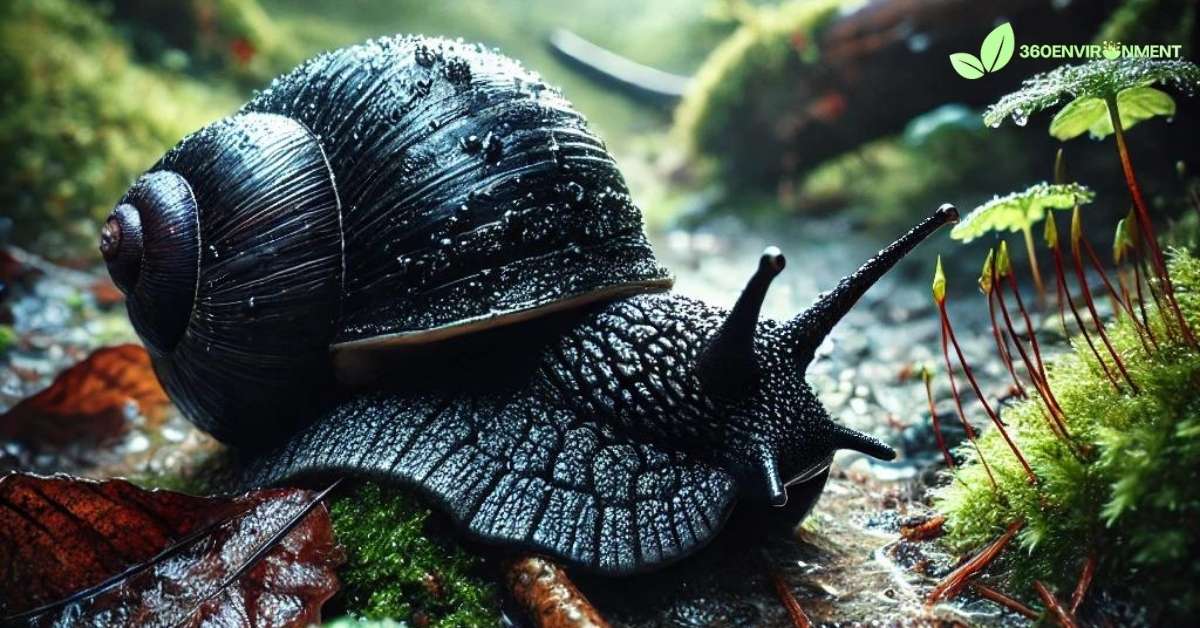The black snail, a term that can refer to various species of snails with dark, sometimes black, exteriors, plays a significant role in many ecosystems. Snails in general are vital in nutrient cycling, soil health, and as prey for numerous predators, but black snails, due to their unique adaptations and habitat preferences, add their own specific contributions to the environments they inhabit. While the term “black snail” might refer to a number of species, some common examples include the Cepaea nemoralis with dark shell variants, or freshwater species like Melanoides tuberculata and Planorbella trivolvis. In this article, we will examine the environmental niche of black snails, looking at their distribution, habitats, feeding habits, ecological interactions, and the conservation challenges they face.
1. Habitat and Geographic Distribution of Black Snails
Black snails are not confined to a single habitat type or geographic region; rather, they occupy a diverse range of environments, from terrestrial ecosystems to freshwater habitats like lakes, rivers, and streams. Their adaptability and unique survival strategies make them prevalent in various ecosystems worldwide.
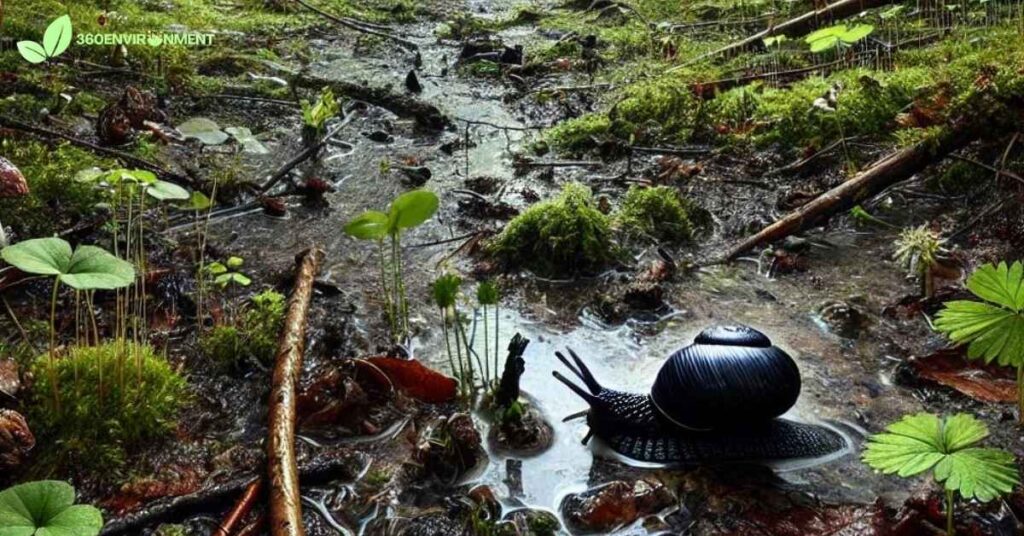
1.1. Terrestrial Habitats
Black snails found in terrestrial environments, such as forests, grasslands, and gardens, are typically slow-moving herbivores or detritivores, feeding on a variety of plant material and decaying organic matter. These species can be found in damp, shaded environments where moisture is abundant.
- Woodland Habitats: In woodlands and forest floors, black snails play an important role in breaking down decaying leaves and plant matter. These snails are often nocturnal, coming out at night when humidity levels are higher and temperatures cooler. Species like Cepaea nemoralis, which have dark shell morphs, are often found in these habitats.
- Gardens and Urban Areas: Black snails are also common in human-modified environments like gardens, parks, and urban spaces. Here, they can often be seen grazing on plant leaves and contributing to the breakdown of organic waste. They are particularly drawn to damp garden areas with abundant vegetation, which provides both food and shelter.
1.2. Freshwater Habitats
Freshwater ecosystems are home to several species of black snails, including some that inhabit lakes, rivers, ponds, and even brackish water. These aquatic snails are highly adapted to life in water and often have gills or modified lungs that allow them to thrive in a range of aquatic environments.
- Ponds, Lakes, and Streams: Species like Planorbella trivolvis, a dark-colored ramshorn snail, can be found in slow-moving freshwater habitats like ponds and lakes. These snails feed on algae, detritus, and decaying plant matter, helping to clean up aquatic ecosystems by recycling organic material.
- Brackish Waters: Some black snails, such as Melanoides tuberculata (the red-rimmed melania), are tolerant of brackish water conditions and can be found in estuarine environments. These snails are important for maintaining water quality, as they consume algae and other microorganisms in the water.
1.3. Marine Habitats
Although less commonly associated with black snails, there are some marine snails with dark or black shells. These species are typically found in intertidal zones, rocky shorelines, and coral reefs, where they have adapted to the challenges of living in saltwater environments.
- Intertidal Zones: Some black marine snails, such as those in the Littorina genus, are commonly found in intertidal areas, where they must cope with fluctuating water levels and exposure to the air during low tide. These snails often feed on algae growing on rocks and other surfaces in these environments.
2. Adaptations of Black Snails
The survival of black snails in a variety of environments is due to their numerous physical and behavioral adaptations. These adaptations help them navigate the challenges of their respective ecosystems, whether on land, in freshwater, or in marine environments.
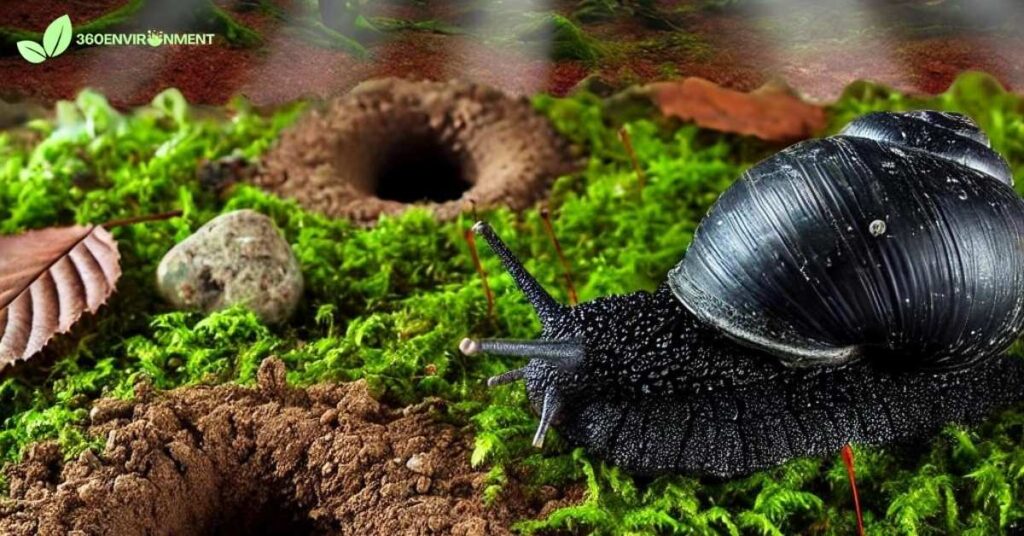
2.1. Shell Color and Camouflage
The dark coloration of black snails provides them with a form of camouflage, helping them blend into their surroundings and avoid predation. In both terrestrial and aquatic environments, their dark shells allow them to remain inconspicuous against dark soil, leaf litter, or algae-covered rocks.
- Thermoregulation: In some cases, the black coloration of the shell helps with thermoregulation. Dark colors absorb more heat, which can be advantageous for snails living in cooler environments, helping them to warm up more quickly during periods of sunlight. However, in hotter environments, this can be a disadvantage, so black snails often seek out shade during the hottest parts of the day.
- Predator Avoidance: Many predators rely on visual cues to locate their prey, and the dark coloration of black snails helps them avoid detection. In forested or aquatic environments, where shadows and dark surfaces are common, their black shells allow them to blend in more easily, making it harder for predators like birds, fish, or larger invertebrates to spot them.
2.2. Moisture Retention and Survival in Harsh Conditions
For terrestrial black snails, moisture retention is critical for survival, as they rely on a moist environment to prevent desiccation. These snails have evolved several strategies to help them retain moisture and survive in drier conditions.
- Mucus Production: One of the primary adaptations of snails is their ability to produce mucus, which not only helps them move across surfaces but also prevents their soft bodies from drying out. This mucus forms a protective barrier that slows down water loss.
- Burrowing Behavior: In times of drought or extreme heat, black snails often retreat into the soil or seek shelter under rocks and logs. This behavior helps them conserve moisture and avoid the desiccating effects of the sun. Some species may enter a state of dormancy, known as estivation, during particularly dry periods, sealing themselves inside their shells until conditions improve.
2.3. Respiration and Water Balance
Aquatic black snails have evolved specialized respiratory systems to cope with their underwater environments. These snails must maintain a balance between their oxygen needs and the risk of dehydration or drowning, depending on the water conditions.
- Gill Respiration: Many aquatic black snails, especially those living in freshwater, have gills that allow them to extract oxygen from the water. This adaptation is crucial for species like Planorbella trivolvis that inhabit oxygen-rich waters, where they must compete with other organisms for limited oxygen supplies.
- Air-Breathing Adaptations: Some freshwater snails, such as Melanoides tuberculata, have evolved the ability to breathe air using a modified lung. This allows them to survive in low-oxygen environments, such as stagnant ponds or streams, where dissolved oxygen levels may be too low for gill respiration alone.
3. Ecological Role of Black Snails
Black snails, like all snails, play a crucial role in the ecosystems they inhabit. From their contribution to nutrient cycling to their position in the food web, black snails are key players in maintaining the balance of their environments.
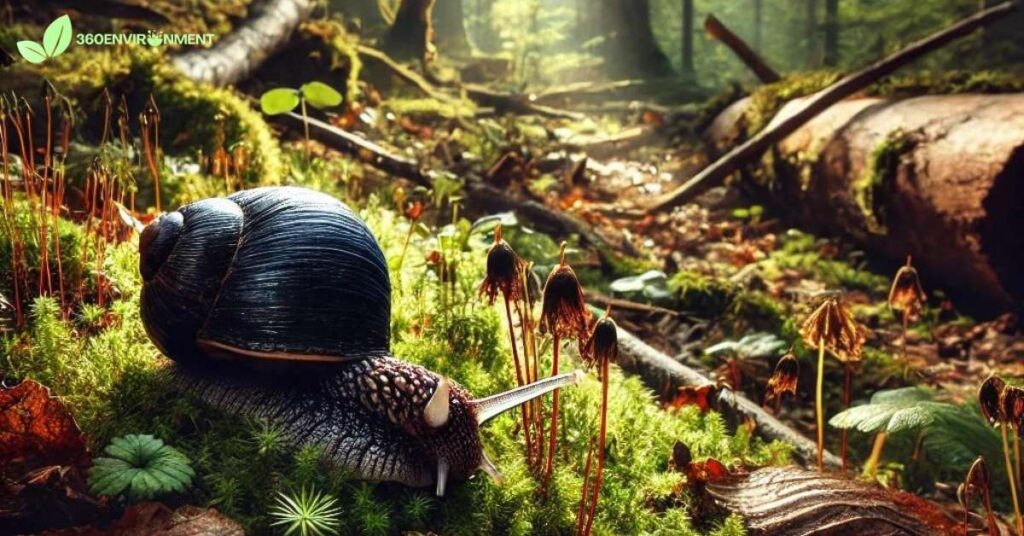
3.1. Nutrient Cycling and Decomposition
One of the primary ecological roles of black snails is their contribution to nutrient cycling, particularly in terrestrial and freshwater ecosystems. By feeding on decaying plant material, algae, and detritus, black snails help break down organic matter and recycle nutrients back into the ecosystem.
- Decomposers in Terrestrial Ecosystems: In forests and grasslands, terrestrial black snails help break down fallen leaves, dead plants, and other organic debris. Their feeding activities accelerate the decomposition process, making nutrients like nitrogen and phosphorus available to other plants and microorganisms. This role is essential for maintaining soil fertility and supporting healthy plant growth.
- Algae Control in Aquatic Ecosystems: In freshwater environments, black snails play a similar role by feeding on algae and detritus. This helps control algal growth, preventing the overgrowth of algae that can lead to problems like eutrophication. By consuming excess algae, black snails help maintain water quality and balance within aquatic ecosystems.
3.2. Prey for Predators
Black snails are an important food source for a wide range of predators, including birds, mammals, fish, amphibians, and invertebrates. Their place in the food web ensures that energy is transferred from primary producers (plants and algae) to higher trophic levels.
- Bird Predators: Birds such as thrushes, crows, and ducks frequently feed on snails, using their strong beaks to crack open the snails’ shells. Some bird species have developed specialized feeding behaviors to extract snails from their shells with remarkable precision.
- Fish and Aquatic Predators: In freshwater ecosystems, fish such as sunfish and perch prey on aquatic snails, while larger invertebrates like crayfish and water beetles may also feed on them. Black snails provide a vital source of protein for these predators, especially during the breeding season when the demand for energy is high.
3.3. Competition with Other Species
In some ecosystems, black snails may compete with other snail species or invertebrates for resources such as food and habitat. This competition can influence the composition and diversity of snail communities in both terrestrial and aquatic environments.
- Invasive Species Interactions: Invasive snail species, such as Melanoides tuberculata, can outcompete native snail species for food and habitat, leading to changes in the structure of aquatic ecosystems. These invasive snails reproduce quickly and can tolerate a wide range of environmental conditions, giving them a competitive advantage over native species.
- Resource Partitioning: In ecosystems where multiple snail species coexist, resource partitioning may occur. Different species may specialize in feeding on different types of plants or algae, or they may occupy different microhabitats within the same environment. This reduces direct competition and allows for greater biodiversity within the ecosystem.
4. Conservation of Black Snails
Despite their ecological importance, black snails face numerous threats to their survival. Habitat loss, pollution, climate change, and invasive species all contribute to the decline of snail populations in many parts of the world. Conservation efforts are needed to protect these valuable organisms and ensure the continued health of the ecosystems they support.
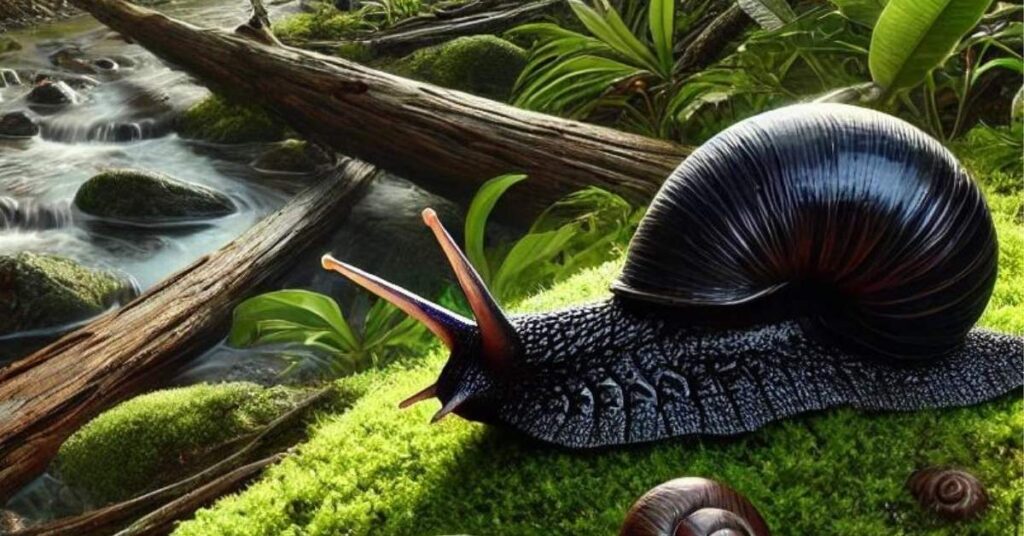
4.1. Habitat Loss and Fragmentation
One of the biggest threats to black snails is the destruction and fragmentation of their natural habitats. Urbanization, agriculture, and deforestation have led to the loss of many snail habitats, particularly in terrestrial environments.
- Deforestation and Land Conversion: In forested areas, the removal of trees and vegetation can disrupt the moisture balance that terrestrial black snails depend on. Without adequate leaf litter and plant cover, these snails are more vulnerable to desiccation and predation. In agricultural landscapes, the use of heavy machinery can compact soil and destroy snail habitats, further contributing to population declines.
- Wetland Drainage and Water Pollution: In freshwater environments, the drainage of wetlands and pollution from agricultural runoff, industrial waste, and urban development pose significant threats to aquatic black snails. Pollutants like heavy metals and pesticides can accumulate in snail populations, leading to reproductive failure, deformities, and increased mortality.
4.2. Invasive Species and Competition
The introduction of non-native snail species has had a significant impact on native snail populations, particularly in aquatic ecosystems. Invasive species can outcompete native snails for food and habitat, leading to declines in biodiversity and changes in ecosystem dynamics.
- Impact of Melanoides tuberculata: The red-rimmed melania (Melanoides tuberculata) is an invasive species that has spread to many freshwater ecosystems around the world. This species reproduces rapidly and can tolerate a wide range of environmental conditions, making it a formidable competitor to native black snail species. Invasive snails like Melanoides tuberculata can disrupt food webs by displacing native species and altering nutrient cycling processes.
- Disease Transmission: Some invasive snail species are vectors for parasitic diseases, such as schistosomiasis, which can affect both humans and wildlife. The spread of these snails can exacerbate public health concerns and increase the need for snail population management and control efforts.
4.3. Climate Change and Its Effects on Black Snails
Climate change poses a growing threat to black snails, as changes in temperature, precipitation patterns, and extreme weather events can alter the habitats they rely on for survival. Terrestrial and aquatic snails are particularly sensitive to changes in moisture availability, making them vulnerable to the effects of global warming.
- Drought and Moisture Stress: Terrestrial black snails are highly dependent on moisture, and prolonged droughts can severely impact their populations. As global temperatures rise and precipitation patterns shift, some regions may experience more frequent and intense droughts, leading to habitat loss and population declines for moisture-dependent snail species.
- Rising Water Temperatures: In aquatic ecosystems, rising water temperatures can disrupt the delicate balance of oxygen availability and nutrient cycling that black snails rely on. Warmer waters can reduce dissolved oxygen levels, making it harder for gill-breathing snails to survive. Additionally, higher temperatures can increase the growth of harmful algae blooms, which can reduce water quality and create toxic conditions for aquatic life.
5. Promoting Black Snail Conservation
Efforts to conserve black snails must address the various threats they face, from habitat destruction to climate change. By protecting their habitats, reducing pollution, and managing invasive species, we can help ensure the survival of these important organisms.
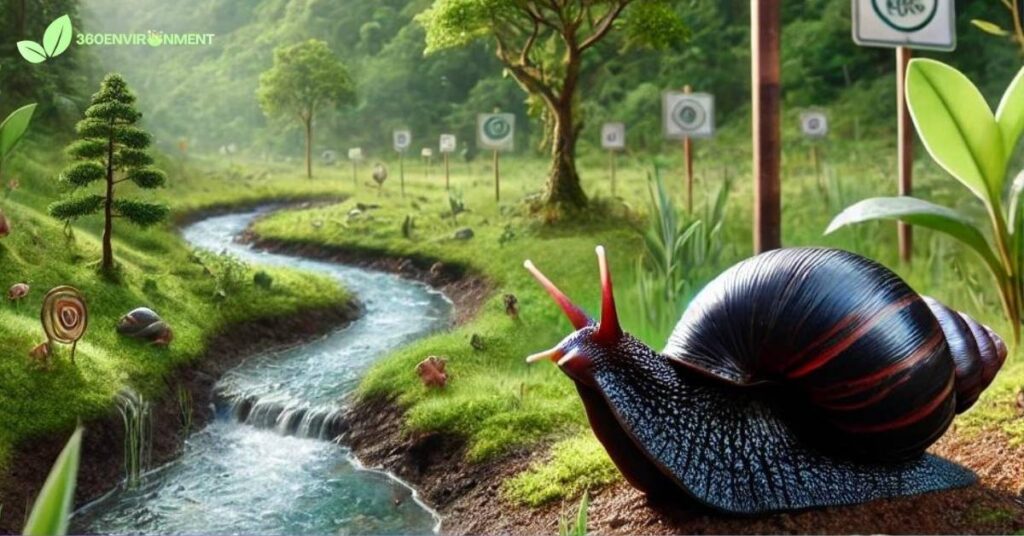
5.1. Habitat Restoration and Protection
One of the most effective ways to conserve black snails is to protect and restore their natural habitats. This can involve reforesting degraded areas, preserving wetlands, and creating protected zones where snail populations can thrive.
- Wetland Restoration: Restoring degraded wetlands and protecting existing wetlands can help support aquatic black snail populations. Wetlands serve as important breeding and feeding grounds for many snail species, and their restoration can also benefit a wide range of other aquatic organisms, including fish, amphibians, and birds.
- Urban Habitat Creation: In urban areas, creating green spaces such as parks and gardens that mimic natural habitats can help support terrestrial black snails. Providing areas with leaf litter, plant cover, and moisture can create suitable habitats for snails in otherwise inhospitable environments.
5.2. Reducing Pollution and Contaminants
Addressing the issue of water and soil pollution is critical for protecting black snail populations, especially in areas where agricultural runoff, industrial waste, and chemical pollution are prevalent.
- Reducing Agricultural Runoff: Implementing sustainable agricultural practices, such as reducing the use of chemical fertilizers and pesticides, can help prevent harmful runoff from entering aquatic ecosystems. Riparian buffer zones, which involve planting vegetation along waterways, can also help filter out pollutants before they reach snail habitats.
- Addressing Water Pollution: Reducing industrial discharges, preventing plastic pollution, and promoting proper waste disposal can improve water quality and support healthy aquatic ecosystems where black snails live.
5.3. Managing Invasive Species
Managing invasive species is essential for protecting native black snail populations. In some cases, invasive snail species may need to be removed or controlled to prevent them from outcompeting native snails or spreading disease.
- Invasive Snail Removal: In areas where invasive snails are threatening native populations, targeted removal efforts can help reduce their impact. This may involve manual removal, trapping, or the use of biological controls that target invasive species without harming native snails.
- Monitoring and Research: Ongoing monitoring of snail populations and habitats is essential for detecting the spread of invasive species and assessing the effectiveness of conservation efforts. Research into the ecology and behavior of invasive snails can also help inform management strategies.
Conclusion: The Ecological Importance of Black Snails
Black snails are key components of many ecosystems, contributing to nutrient cycling, serving as prey for a variety of animals, and maintaining the balance of their environments. Despite their small size, they play a vital role in both terrestrial and aquatic ecosystems, helping to sustain biodiversity and support healthy ecosystems.
However, black snails face significant threats from habitat destruction, pollution, invasive species, and climate change. Conservation efforts are essential for protecting these important organisms and ensuring their continued survival. By restoring and protecting their habitats, reducing pollution, and managing invasive species, we can help safeguard the future of black snails and the ecosystems they inhabit. Through these efforts, we not only protect black snails but also promote the health and resilience of the broader ecosystems that depend on them.
Read More: Are Turtles Reptiles or Amphibians? Exploring Their Environmental Niche, Classification, and Ecology

